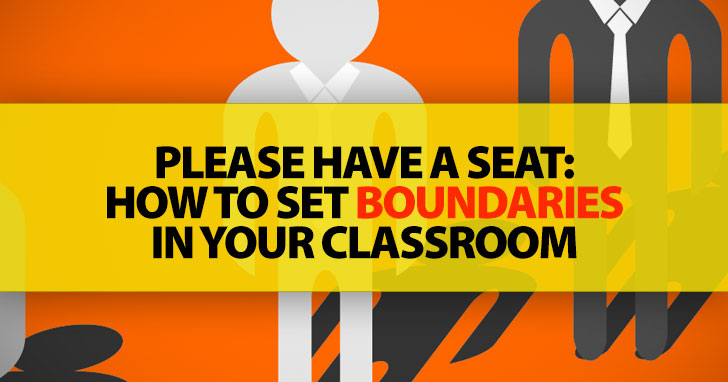Please Have A Seat: How To Set Boundaries In Your Classroom


Because there was no real common factor in such people, such as gender, body size, pitch of voice, and so forth, I thought for a long time that their boundaries were somewhat magical, innate to them and communicated mysteriously to others. On the contrary, however, there are definite strategies for establishing and communicating personal boundaries that can be learned. For ESL students, especially if they come from a place where personal freedoms are limited, “boundaries” may seem a foreign concept. However, it may be more universal than cultural in that everyone has a sense of how they would like to be treated, which is really what a boundary is—how we would, and would not, like to be treated. Students, and ESL students, may in particular have trouble with boundaries, not really recognizing knowing how to establish and communicate them, but there are ways to teach establishing healthy boundaries.

Most people may have thought of boundaries, or the concept of it, without really naming it—as when I was younger I was able to recognize the people that effortlessly communicated boundaries, but I really didn’t have a definition or a firm grasp on the essential qualities of the concept. Therefore it’s necessary to define it and discuss it.

How do you want others to treat you? Are you okay with others interrupting you when you’re working, for example, or does this bother you? Before you communicate your boundaries to others, you have to decide what they are yourself—otherwise, you may find yourself always upset with the roommate you actually like, but who’s always popping into your room while you’re studying, without really knowing why.
It may be just the case that the roommate who’s always coming into your room is just thoughtless—she doesn’t consider you might be studying when she comes in really needing to talk about the party Friday night. But it may also be that she does have certain items she really needs to discuss with you, like the rent payment, but never has a chance because you are always either at school, at work, or studying. The first step to getting your needs met is to recognize other’s, so if you set aside regular time to talk to your roommate, she may have less need to interrupt you while studying.
Suppose you do make an effort to regularly talk with your roommate, and she still interrupts you while you’re studying. This might indicate a boundaries issue, and requires some clear communication: “I’m sorry; this is my study time, so I can’t talk. I can talk to you later at dinner, as we’ve discussed before.” If the interrupting has been going on for a long time, this might need to be repeated several times before the roommate understands that you’re serious.

“Boundary” is a hard idea to grasp, even for native speakers of English, perhaps because it is such an abstract concept and varies from person to person. Therefore, make the abstract more concrete through analogy and example. “Boundary” is roughly synonymous with “border,” a concept that most students are already familiar with. One option is to show a map of the United States and discuss the borders or boundaries between a few of the states—where the boundary between California and Nevada lies, for example. (This is incidentally a way to also teach the geography of the United States, something many Americans have trouble with.) Discuss what this boundary means: a change in laws, for example, as gambling and prostitution have both historically been legal in Nevada but not in California. This shows the literal meaning of “boundary,” a demarcation between separate entities. Also give the example of physical boundaries. Most people will have a sense of their physical boundaries, if not their emotional ones, even if they’ve never thought about them consciously. For example, I’ve worked with a volunteer student who sits at the front of the room and reads while I move closer and closer to her until I’m almost right on top of her while looking over her shoulder. Usually the class will start laughing as I move closer, and after the demonstration I’ll discuss why: because I had violated the student’s boundaries in a visible way. I also ask the student at what point she became uncomfortable—and volunteers always do become uncomfortable sooner or later during this exercise. Although they may vary culturally, boundaries exist across cultures, and physical boundaries are the most obvious.
Once the meaning of “boundary” is clear, it’s time to extend the discussion, further solidifying the concept while students also explore their understanding of their own personal boundaries. One option is to pass out a list of requests or expectations that others might impose from being available to babysit to moving into your home. Students should discuss and rank what they would be willing to do and under what circumstances—e.g., a “1” means I would not consider it a boundaries violation if a roommate helped herself to the food in our common refrigerator under almost any circumstances while“10” means I would consider it an extreme violation of boundaries for a roommate’s friend to camp out on our sofa, except in a really dire situation. Discussions like these demonstrate in detail what boundaries are and how they apply.
Showing different “case studies” and examples, drawn from life, perhaps, of boundaries violations as well as defending boundaries will solidify the concept in students’ minds while also showing them ways of addressing issues related to boundaries. A common situation, especially to poor or young people, is moving into a new place that has an “extra” room and how this often brings on requests to stay in that room (especially if the residence is located in a desirable area, such as near a beach). Discussing what “Janice” should do about the avalanche of requests to “visit” her--some from family, some from people she barely knows—again develops understanding of boundaries, as most of us have, or should have, boundaries related to whom we live with.
Role play is also a powerful instructional tool in addressing the concept of boundaries. For example, have students work in pairs on simple scenarios that have been written on index cards, such as demand for money, invasive questions, and so on, one student making the request or demand while the other student establishes the boundary: “I’m afraid I can’t lend that amount,” “I’d rather not answer that,” and so forth. Not having a scripted scene but rather just as the general situation given forces students to think on their feet, which is what really is demanded in everyday conversation.
Establishing boundaries is a hard task for almost anyone in any culture. It is, however, for personal comfort, or even safety, necessary. Some investment of class time in helping students define, identify, and establish personal boundaries is therefore time well-spent in helping them navigate their new country.
If so, how would you teach it?